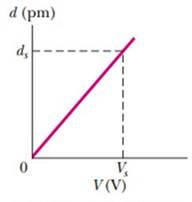Problem 1Q: Figure 25-18 shows plots of charge versus potential difference for three parallel-plate capacitors... Problem 2Q: What is Ceq of three capacitors, each of capacitance C, if they are connected to a battery a in... Problem 3Q: a In Fig. 25-19a are capacitors 1 and 3 in series? b In the samefigure, are capacitors 1 and 2 in... Problem 4Q: Figure 25-20 shows three circuits, each consisting of a switch and two capacitors, initially charged... Problem 5Q: Initially, a single capacitance C1 is wired to a battery. Then capacitance C2 is added in parallel.... Problem 6Q: Repeat Question 5 for C2 added in series rather than in parallel. Problem 7Q: For each circuit in Fig. 25-21, are the capacitors connected in series, in parallel, or in neither... Problem 8Q: Figure 25-22 shows an open switch, a battery of potential difference V, a current-measuring meter A,... Problem 9Q: A parallel-plate capacitor is connected to a battery of electric potential difference V. If the... Problem 10Q: When a dielectric slab is inserted between the plates of one of the two identical capacitors in Fig.... Problem 11Q: You are to connect capacitances C1 and C2, with C1C2, to a battery, first individually, then in... Problem 1P: The two metal objects in Fig. 25-24 have net charges of 70 pC and 70 pC, which result in a 20 V... Problem 2P: The capacitor in Fig. 25-25 has a capacitance of 25 F and is initially uncharged. The battery... Problem 3P: SSM A parallel-plate capacitor has circular plates of 8.20 cm radius and 1.30 mm separation. a... Problem 4P: The plates of spherical capacitor have radii 38.0 mm and 40.0 mm. a Calculate the capacitance. b... Problem 5P: What is the capacitance of a drop that results when two mercury spheres, each of radius R = 2.00 mm,... Problem 6P: You have two flat metal plates, each of area 1.00m2, with which to construct a parallel-plate... Problem 7P: If an uncharged parallel-plate capacitor capacitance C is connected to a battery, one plate becomes... Problem 8P: How many 1.00 F capacitors must be connected in parallel to store a charge of 1.00 C with a... Problem 9P: Each of the uncharged capacitors in Fig. 25-27 has a capacitance of 2.50 F. A potential difference... Problem 10P: In Fig. 25-28, find the equivalent capacitance of the combination. Assume that C1is 10.0 F, C2is... Problem 11P: In Fig. 25-29, find the equivalent capacitance of the combination. Assume that C1 = 10.0 F, C2=5.00F... Problem 12P: Two parallel-plate capacitors, 6.0 F each, are connected in parallel to a 10 V battery. One of the... Problem 13P: SSM ILW A 100 pF capacitor is charged to a potential difference of 50 V, and the charging battery is... Problem 14P: GO In Fig. 25-30, the battery has a potential difference of V = 10.0 V and the five capacitors each... Problem 15P: GO In Fig. 25-31, a 20.0 V battery is connected across capacitors of capacitances C1 = C6 = 3.00 FC3... Problem 16P: Plot in Fig. 25-32a gives the charge q that can be stored on capacitor 1 versus the electric... Problem 17P: GO In Fig. 25-29, a potential difference of V = 100.0 V is applied across a capacitor arrangement... Problem 18P: Figure 25-33 shows a circuit section of four air-filled capacitors that is connected to a larger... Problem 19P: GO In Fig. 25-34, the battery has potential difference V = 9.0 V, C2 = 3.0 F, C4 = 4.0 F, and all... Problem 20P: Figure 25-35 shows a variable "airgap capacitor for manual tuning. Alternate plates are connected... Problem 21P: SSM WWWIn Fig. 25-36, capacitances are charged C1 = 1.0 F and C2 = 3.0 F, and both capacitors are... Problem 22P: In Fig. 25-37, V = 10 V, C1 = 10 F, and C2 = C3 = 20 F. Switch S is first thrown to the left side... Problem 23P: The capacitors in Fig. 25-38 are initially uncharged. The capacitances are C1 = 4.0 F, C2 = 8.0 F,... Problem 24P: GO Figure 25-39 represents two air-filled cylindrical capacitors connected in series across a... Problem 25P: GO In Fig. 25-40, two parallel-plate capacitors with air between the plates are connected to a... Problem 26P: GO Capacitor 3 in Fig. 25-41a is a variable capacitor its capacitance C3 can he varied. Figure... Problem 27P: GO Figure 25-42 shows a 12.0 V battery and four uncharged capacitors of capacitances C1= 1.00 F, C2... Problem 28P: GO Figure 25-43 displays a 12.0 V battery and 3 uncharged capacitors of capacitances C1= 4.00 F, C2... Problem 29P: What capacitance is required to store an energy of 10 kWh potential difference of 1000 V? Problem 30P: How much energy is stored in 1.00 m3of air due to the fair weather electric field of magnitude 150... Problem 31P: SSMA 2.0 F capacitor and a 4.0 F capacitor are connected in parallel across a 300 V potential... Problem 32P: A parallel-plate air-filled capacitor having area 40 cm2 and plate spacing 1.0 mm is charged to a... Problem 33P: A charged isolated metal sphere of diameter 10 cm has a potential of 8000 V relative to V = 0 at... Problem 34P: In Fig. 25-28, a potential difference V = 100 V is applied across a capacitor arrangement with... Problem 35P: Assume that a stationary electron is a point of charge. What is the energy density u of its electric... Problem 36P: As a safety engineer, you must evaluate the practice of storing flammable conducting liquids in... Problem 37P: SSM ILW WWW The parallel plates in a capacitor, with a plate area of 8.50 cm2 and an air-filled... Problem 38P: In Fig. 25-29, a potential difference V = 100 V is applied across a capacitor arrangement with... Problem 39P: Go In Fig. 25-45, C1 = 10.0 F, C2= 20.0 F, and C3 = 25.0 F. If no capacitor can withstand a... Problem 40P: An air-filled parallel-plate capacitor has a capacitance of 1.3 pF.The separation of the plates is... Problem 41P: SSMA coaxial cable used in a transmission line has an inner radius of 0.10 mm and an outer radius of... Problem 42P: A parallel-plate air-filled capacitor has a capacitance of 50 pF. a If each of its plates has an... Problem 43P: Given a 7.4 pF air-filled capacitor, you are asked to convert it to a capacitor that can store up to... Problem 44P: You are asked to construct a capacitor having a capacitance near 1 nF and a breakdown potential in... Problem 45P: A certain parallel-plate capacitor is filled with a dielectric for which = 5.5. The area of each... Problem 46P: In Fig. 25-46, how much charge is stored on the parallel-plate capacitors by the 12.0 V battery? One... Problem 47P: SSM ILWA certain substance has a dielectric constant of 2.8 and a dielectric strength of 18 MV/m. If... Problem 48P: Figure 25-47 shows a parallel-plate capacitor with a plate area A = 5.56 cm2 and separation d = 5.56... Problem 49P: Figure 25-48 shows a parallel-plate capacitor with a plate area A = 7.89 cm2 and plate separation d... Problem 50P: Go Figure 25-49 shows a parallel-plate capacitor of plate area A = 10.5 cm2and plate separation 2d =... Problem 51P: SSM WWWA parallel-plate capacitor has a capacitance of 100 pF, a plate area of 100 cm2, and a mica... Problem 52P: For the arrangement of Fig. 25-17, suppose that the battery remains connected while the dielectric... Problem 53P: A parallel-plate capacitor has plates of area 0.12 m2 and a separation of 1.2 cm. A battery charges... Problem 54P: Two parallel plates of area 100 cm2 are given charges of equal magnitudes 8.9107C but opposite... Problem 55P: The space between two concentric conducting spherical shells of radii b = 1.70 cm and a = 1.20 cm is... Problem 56P: In Fig. 25-50, the battery potential difference V is 10.0 V and each of the seven capacitors has... Problem 57P: SSMIn Fig. 25-51, V = 9.0 V, C1 = C2= 30 F, and C3 = C4 = 15 F. What is the charge on capacitor 4?... Problem 58P: a If C = 50 F in Fig. 25-52, what is the equivalent capacitance between points A and B? Hint: First... Problem 59P: In Fig.25-53, V = 12 V, C1 = C4 = 2.0 F, C2 = 4.0 F, and C3 = 1.0 F. What is the charge on capacitor... Problem 60P: The chocolate crumb mystery. This troy begins with Problem 60 in Chapter 23. As part of the... Problem 61P: Figure 25-54 shows capacitor 1 C1 = 8.00 F, capacitor 2 C2 = 6.00 F, and capacitor 3 C3 = 8.00 F,... Problem 62P: Two air-filled, parallel-plate capacitors are to be connected to a 10 V battery, first individually,... Problem 63P: Two parallel-plate capacitors, 6.0 F each, are connected in series to a 10 V battery. One of the... Problem 64P: GO In Fig. 25-55, V = 12 V, C1 = C5 = C6 = 6.0 F, and C2 = C3 = C4 = 4.0 F. What are a the net... Problem 65P: SSM In Fig.25-56, the parallel-plate capacitor of plate area 2.00 10-2 m2 is filled with two... Problem 66P: A cylindrical capacitor has radii a and b as in Fig. 25-6. Show that half the stored electric... Problem 67P: A capacitor of capacitance C1 = 6.00 F is connected in series with a capacitor of capacitance C2 =... Problem 68P: Repeat Problem 67 for the same two capacitors but with them now connected in parallel. Problem 69P: A certain capacitor is charged to a potential difference V. If you wish to increase its stored... Problem 70P: Aslab of copper of thickness b = 2.00 mm is thrust into a parallel-plate capacitor of plate area A =... Problem 71P: Repeat Problem 70, assuming that a potential difference V = 85.0 V, rather than the charge, is held... Problem 72P: A potential difference of 300 V is applied to a series connection of two capacitors of capacitances... Problem 73P: Figure 25-58 shows a four capacitor arrangement that is connected to a larger circuit at points A... Problem 74P: You have two plates of copper, a sheet of mica thicknes = 0.10 mm, = 7.0, and a slab of paraffin... Problem 75P: A capacitor of unknown capacitance Cis charged to 100 V and connected across an initially uncharged... Problem 76P: A 10 V battery is connected to a series of n capacitors, each of capacitance 2.0 F. If the total... Problem 77P: SSM In Fig. 25-59, two parallel-plate capacitors A and B are connected in parallel across a 600 V... Problem 78P: You have many 2.0F capacitors, each capable of withstanding 200 V without undergoing electrical... Problem 79P: A parallel-plate capacitor has charge q and plate area A. a By finding the work needed to increase... Problem 80P: A capacitor is charged until its stored energy is 4.00 J. A second capacitor is then connected to it... format_list_bulleted




 Principles of Physics: A Calculus-Based TextPhysicsISBN:9781133104261Author:Raymond A. Serway, John W. JewettPublisher:Cengage Learning
Principles of Physics: A Calculus-Based TextPhysicsISBN:9781133104261Author:Raymond A. Serway, John W. JewettPublisher:Cengage Learning
